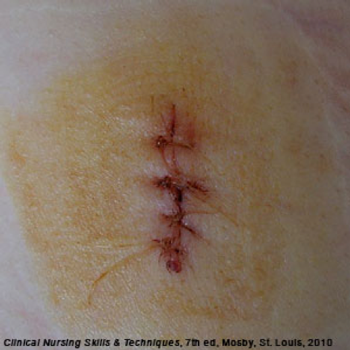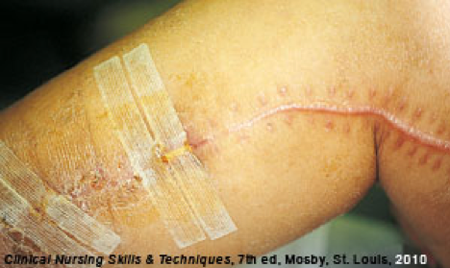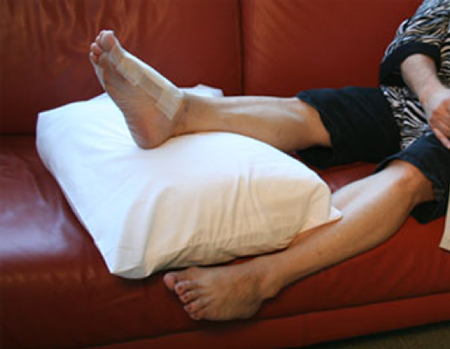There are many ways that you can help a person after their surgery. Always be a good observer and provide support for any orders the surgeon has prescribed. Keep notes in your care diary to describe how the person progresses.
A surgeon closes a wound with stitches, staples or sometimes with glue. In many cases a wound will not be covered with a dressing. It may only be covered with a band-aid.
Look at the wound when the person first comes home, then at least once a day or whenever the person tells you their wound bothers them.
If the wound is covered with a dressing (such as gauze or a clear transparent dressing), the surgeon may or may not have you change it. If you do change it, then look at the wound and dressing during each change. See our lesson on Changing a Gauze Dressing.
If a dressing is covering a wound, it is important for it to remain clean, dry and intact. Do not let the dressing get wet. Talk to the person’s doctor or home health nurse on ways to keep a dressing dry.
Tips on What to look for:
The surgeon will tell you what to expect and give you a list of the type of problems to report. Follow these directions exactly. Here are some tips on what to look for:

First 24 hours

Next 2 to 3 days

Next 3 to 24 days
At times, when a wound heals, the person may feel the need to scratch the area, as it may itch. Discourage this activity as this can cause skin abrasions and infection. Also be sure that the tape holding the dressing is not causing a skin reaction.
When you change a dressing, look at the skin. When the person is sensitive to tape, there will be redness, and sometimes even blisters. If this is noticed, call the doctor or the person’s Home Health nurse.
If an infection forms in a wound, look for these signs:
Ask the doctor or the nurse at the hospital how much bleeding should occur after the surgery and when to call and report bleeding. Call the doctor immediately if unexpected bleeding develops.
Write down what you observe about the wound and dressing in your care diary. If you suspect an infection call the surgeon immediately.
Sometimes a person will come home with a drain or drainage tube placed inside the wound. The purpose is to help drain fluid that builds up inside the wound. A wound always heals from the inside out. Removal of any extra fluid helps a wound heal more quickly.
A person’s activity may or may not be limited after surgery. The surgeon will provide specific guidelines for the person to follow.
Sometimes a person will have specific activity restrictions, depending on the type of surgery. Here are a few examples:
Any physical stress, especially on a surgical wound, can cause the edges of the skin to separate. This is very important during the first 24 to 72 hours after surgery. Protect a person’s wound by following these tips:

A person who has had surgery must know the type of pain to expect after surgery. The surgeon or nurse will explain the type of pain and how long it normally lasts.

A person’s circulation slows during surgery and afterwards as well, if the person is not active right after surgery. When the circulation slows and if the person has any problems with blood clotting, there is the risk of a person forming a deep vein thrombosis or DVT.
A DVT is a blood clot that forms on the inner wall of a vein, most commonly a deep vein in the leg. The risk of a DVT is that it can break off, enter the circulation, and then be carried up to the lung, with the potential of causing death. This risk is common in persons who have had orthopedic or vascular surgery.
Each person will have orders for the type of diet and the amount of fluids to take after surgery. This will depend on their type of surgery, and whether they feel queasy from anesthesia when they go home. For example, if a person has surgery on the digestive tract, return to a normal diet will take a few days. A person who has an arthroscopicprocedure of the knee will be able to eat a normal diet the next day.
The surgeon may order a progressive diet. This means the person may start with full liquids and soft food, and then gradually add solid foods.
As a caregiver, you want to observe:
A return to a normal diet promotes:
Provide meals when a person is rested and pain is mild. If the person feels queasy or sick to their stomach, delay the meal or offer a small snack, such as a piece of toast, or liquid broth. Always offer 8 to 10, eight ounce glasses of fluid each day (unless the person has limits).
For more information, see our lesson on Feeding a Person.